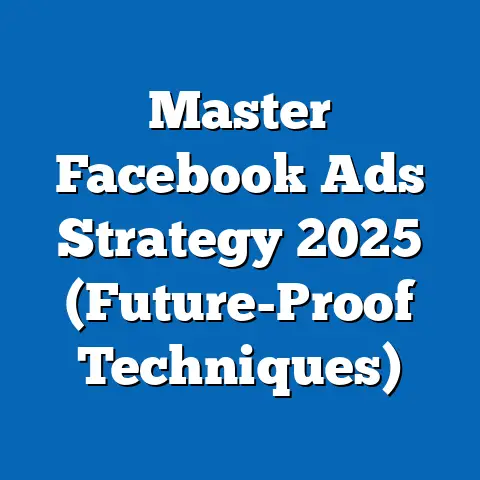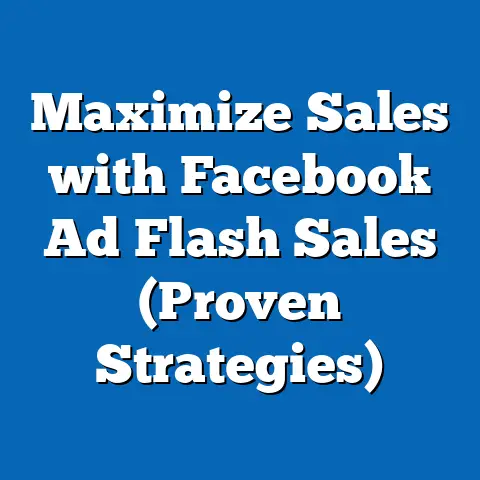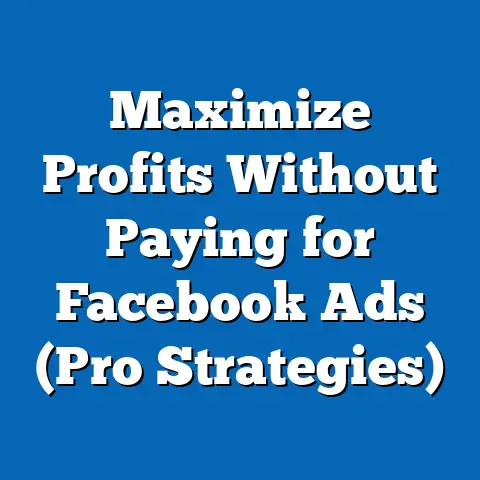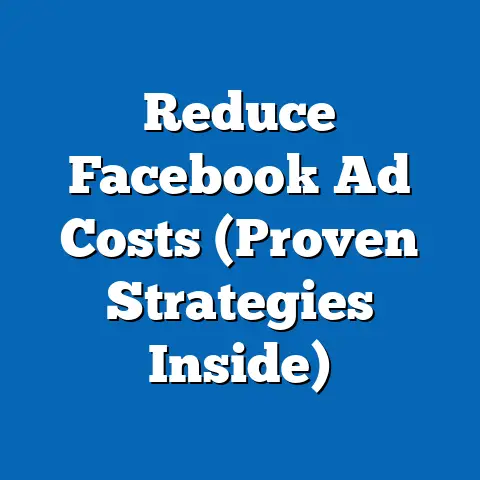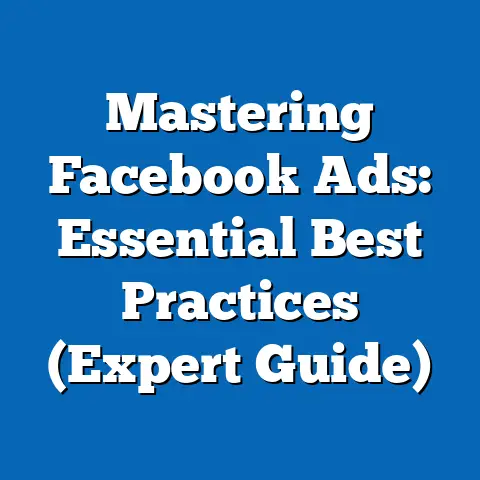Mastering Facebook Ad Levels (Unlock Proven Strategies)
Imagine a small, family-owned bakery in a quiet suburban neighborhood suddenly seeing a 300% spike in online orders within a single week. The secret? A meticulously crafted Facebook ad campaign that leveraged advanced targeting and ad level strategies, turning a modest $500 budget into a revenue windfall of over $15,000. This isn’t a one-off success story; it’s a testament to the power of mastering Facebook ad levels—a hierarchy of campaign structure that, when optimized, can transform businesses of any size.
Facebook advertising, now under the Meta umbrella, remains a dominant force in digital marketing, with over 10 million active advertisers as of 2023, according to Meta’s own reports. Recent data from Statista indicates that global ad spending on the platform reached $113.7 billion in 2022, a 12% increase from the previous year, underscoring its critical role in modern marketing strategies. This article delves into the intricacies of Facebook ad levels—campaigns, ad sets, and ads—offering data-driven insights, demographic breakdowns, historical trends, and future projections to help marketers unlock proven strategies for success.
Understanding Facebook Ad Levels: A Structural Breakdown
The Three-Tier Hierarchy
At its core, Facebook advertising operates on a three-tier structure: campaigns, ad sets, and ads. Each level serves a distinct purpose and requires specific optimization strategies to ensure effectiveness. Let’s break this down with clear definitions and practical implications.
A campaign is the top level, where you define your overarching objective—be it brand awareness, lead generation, or conversions. According to Meta’s 2023 advertising guide, campaigns are the foundation for aligning your marketing goals with budget allocation. Think of this as the “big picture” strategy.
Next, ad sets sit within a campaign and allow for granular control over targeting, budget, and scheduling. This is where you define your audience—by age, location, interests, or behaviors—and decide how much to spend per day or over a lifetime. Data from eMarketer shows that well-segmented ad sets can improve click-through rates (CTR) by up to 26% compared to broadly targeted ones.
Finally, ads are the creative elements—images, videos, carousels, or stories—that users see. This level is where messaging and visuals come into play, directly influencing engagement. Hootsuite’s 2023 Digital Trends report notes that ads with personalized copy and dynamic visuals achieve 35% higher conversion rates on average.
Why Structure Matters
Misalignment at any level can derail a campaign. For instance, a poorly defined ad set targeting an irrelevant audience will waste budget, no matter how compelling the ad creative is. A 2022 study by WordStream found that 62% of small businesses fail to see ROI from Facebook ads due to improper structuring at the campaign or ad set level.
Understanding this hierarchy is akin to building a house: the campaign is the blueprint, the ad set is the foundation, and the ad is the interior design. Neglect any part, and the structure collapses. With this framework in mind, let’s dive into the statistical trends shaping Facebook advertising today.
Key Statistical Trends in Facebook Advertising
Spending and Growth Patterns
Facebook’s advertising ecosystem continues to grow at a remarkable pace. As of 2022, global ad revenue on the platform reached $113.7 billion, up from $101.5 billion in 2021, according to Statista. This 12% year-over-year increase reflects advertisers’ growing reliance on the platform, driven by its unparalleled user base of 2.9 billion monthly active users (MAUs) as reported by Meta in Q2 2023.
Small and medium-sized businesses (SMBs) account for a significant portion of this spending. A 2023 survey by Hootsuite revealed that 70% of SMBs use Facebook ads as their primary digital marketing tool, with an average monthly spend of $1,000 to $5,000. This trend highlights the platform’s accessibility across business sizes.
Performance Metrics
Performance metrics offer a deeper look into how ad levels impact outcomes. The average CTR for Facebook ads across industries in 2023 stands at 0.90%, though this varies widely by sector, per WordStream’s annual report. For instance, retail ads achieve a CTR of 1.59%, while technology lags at 0.86%.
Cost-per-click (CPC) also fluctuates, with a global average of $0.97 in 2023, down slightly from $1.01 in 2022. However, industries like finance and insurance face higher CPCs—up to $3.77—due to competitive bidding. These metrics underscore the importance of optimizing ad sets for niche targeting to control costs while maximizing reach.
Engagement by Ad Format
Ad format plays a critical role at the ad level. Video ads, for example, have surged in popularity, accounting for 45% of total ad impressions in 2023, up from 38% in 2021, per eMarketer. Carousel ads, which allow multiple images or videos in a single ad, boast a 20-30% higher engagement rate compared to single-image ads, according to Meta’s internal data.
These trends suggest that advertisers must prioritize dynamic, interactive content at the ad level while ensuring campaigns and ad sets are aligned with audience preferences. But who are these audiences? Let’s explore the demographic breakdowns driving these numbers.
Demographic Breakdowns: Who Responds to Facebook Ads?
Age and Gender Insights
Facebook’s user base spans a wide demographic spectrum, but certain groups engage more with ads. According to Statista’s 2023 data, 25-34-year-olds represent the largest user segment at 31.5% of MAUs, followed by 18-24-year-olds at 23.8%. These younger cohorts are also the most likely to click on ads, with a CTR of 1.2% for 18-34-year-olds compared to just 0.5% for users aged 55+, per WordStream.
Gender differences are less pronounced but still notable. Men account for 56% of global users and show a slightly higher CTR (0.95%) compared to women (0.85%). However, women are more likely to convert on e-commerce ads, with a conversion rate of 2.1% versus 1.8% for men, as reported by eMarketer.
Geographic Variations
Geography significantly influences ad performance due to differences in purchasing power and digital adoption. North America, despite having only 10% of Facebook’s global users, generates 48% of ad revenue due to higher CPCs averaging $2.50, according to Meta’s Q2 2023 earnings report. In contrast, the Asia-Pacific region, with 42% of users, contributes just 28% of revenue due to lower CPCs of around $0.40.
Emerging markets like India and Brazil show the fastest growth in ad engagement, with year-over-year increases of 18% and 15%, respectively, per Hootsuite. This suggests that tailoring ad sets to local languages, cultures, and economic contexts can yield significant returns in these regions.
Behavioral and Interest-Based Targeting
At the ad set level, behavioral and interest-based targeting remains a game-changer. Users interested in technology and gaming show a 40% higher CTR compared to general audiences, while those engaging with health and wellness content convert at rates 25% above average, per Meta’s 2023 advertiser insights. Leveraging these insights allows marketers to refine ad sets for hyper-specific audiences, improving overall campaign performance.
These demographic variations highlight the need for precision at every ad level. But how have these trends evolved over time? A historical comparison offers valuable context.
Historical Comparisons: Evolution of Facebook Advertising
Early Days vs. Modern Era (2007-2023)
When Facebook launched its ad platform in 2007, it was a rudimentary system focused on basic banner ads with minimal targeting options. By 2012, ad revenue reached $5 billion, driven by the introduction of mobile ads as smartphone adoption surged. Compare this to 2022’s $113.7 billion, and the platform’s growth trajectory is staggering—a 2,174% increase over a decade, per Statista.
Targeting capabilities have also transformed. In 2012, ad sets were limited to basic demographics like age and location. By 2018, the introduction of machine learning algorithms enabled lookalike audiences and predictive targeting, boosting CTRs by an estimated 30%, according to eMarketer’s historical analysis.
Impact of Privacy Changes
Historical trends cannot be discussed without addressing privacy regulations. The 2018 Cambridge Analytica scandal and subsequent policies like the General Data Protection Regulation (GDPR) forced Meta to overhaul data usage practices. This led to a temporary dip in ad revenue growth in 2019, with a year-over-year increase of only 27% compared to 37% in 2018, per Meta’s annual reports.
Apple’s iOS 14.5 update in 2021, which introduced App Tracking Transparency (ATT), further disrupted ad tracking, costing Meta an estimated $10 billion in lost revenue in 2022. However, advertisers adapted by focusing on first-party data and contextual targeting at the ad set level, stabilizing performance metrics by 2023.
Shifts in Ad Formats
Ad formats have evolved alongside technology. Static image ads dominated until 2015, when video ads began gaining traction, rising from 10% of impressions to 45% by 2023, as noted earlier. Stories ads, introduced in 2018, now account for 20% of impressions, reflecting users’ preference for ephemeral, full-screen content, per Hootsuite.
These historical shifts demonstrate how external factors—technology, regulation, and user behavior—shape ad level strategies. Marketers who adapted to these changes by refining campaigns and ad sets consistently outperformed those who didn’t.
Detailed Analysis: Strategies for Mastering Each Ad Level
Campaign Level: Setting the Right Objective
At the campaign level, choosing the right objective is paramount. Meta offers 11 objectives across three categories—awareness, consideration, and conversion. A 2023 study by Social Media Examiner found that campaigns focused on “Traffic” or “Conversions” yield a 50% higher ROI compared to broad “Brand Awareness” campaigns for most industries.
Budget allocation also matters. Split testing multiple campaigns with small budgets before scaling is a proven strategy, with 68% of top-performing advertisers using this approach, per WordStream. For example, allocating 20% of the budget to test objectives ensures data-driven decisions before full investment.
Ad Set Level: Precision Targeting and Optimization
Ad sets are where targeting precision can make or break a campaign. Narrowing audiences by layering demographics, interests, and behaviors reduces wasted impressions by 35%, according to Meta’s 2023 advertiser toolkit. For instance, targeting “25-34-year-old women interested in fitness” rather than “all women” can double CTR.
Placement optimization within ad sets is equally critical. Automatic placements across Facebook, Instagram, and Audience Network often outperform manual selections, improving reach by 15%, per eMarketer. Additionally, setting frequency caps—limiting how often users see an ad—prevents ad fatigue, with optimal caps at 2-3 impressions per week, boosting engagement by 10%.
Ad Level: Crafting Compelling Creatives
At the ad level, creativity drives results. Video ads under 15 seconds achieve 60% higher completion rates compared to longer formats, per Meta’s creative guidelines. Including a clear call-to-action (CTA) like “Shop Now” increases conversion rates by 22%, as reported by Hootsuite.
A/B testing ad variations is a must. Testing different headlines, images, or formats within the same ad set reveals winning combinations, with 75% of marketers citing this as their top optimization tactic, per Social Media Examiner. For example, a carousel ad showcasing multiple products might outperform a single-image ad for e-commerce campaigns.
Future Projections: What Lies Ahead for Facebook Ads
Emerging Technologies and AI
Looking ahead, artificial intelligence (AI) will redefine Facebook ad levels. Meta’s investment in AI-driven tools like Advantage+ campaigns, which automate targeting and creative optimization, is already showing promise. Early adopters report a 20% reduction in CPC and a 15% increase in conversions, per Meta’s 2023 Q3 report.
Augmented reality (AR) ads are another frontier. With 30% of users engaging with AR experiences on the platform, eMarketer predicts that AR ad spend will grow by 50% annually through 2027. This suggests a shift toward interactive ad formats at the ad level.
Privacy and Data Challenges
Privacy concerns will continue to shape the landscape. As third-party cookies phase out by 2024, per Google’s timeline, Meta is prioritizing first-party data solutions like on-platform lead forms. Analysts at Forrester predict a 10-15% short-term dip in ad revenue due to these changes, but long-term adaptation will stabilize growth.
Demographic Shifts
Demographic trends point to a younger, more mobile-first audience. Gen Z (born 1997-2012) is projected to make up 25% of Facebook’s user base by 2025, up from 18% in 2023, per Statista. This shift will demand short-form, visually rich ads tailored to mobile consumption, influencing strategies at all ad levels.
Market Expansion
Emerging markets will drive future ad revenue growth. eMarketer forecasts that the Asia-Pacific region will account for 35% of Meta’s ad revenue by 2027, up from 28% in 2023, as digital adoption accelerates. Marketers who localize campaigns and ad sets for these markets will gain a competitive edge.
Conclusion: Unlocking the Power of Facebook Ad Levels
Mastering Facebook ad levels—campaigns, ad sets, and ads—is not just a technical exercise; it’s a strategic imperative for any marketer aiming to thrive in the digital age. From the small bakery that tripled its revenue to multinational brands spending millions annually, the principles remain the same: align objectives at the campaign level, refine targeting at the ad set level, and captivate with creatives at the ad level. The data is clear—global ad spend on the platform continues to climb, with $113.7 billion in 2022 and projected growth fueled by AI, AR, and emerging markets.
Historical trends remind us that adaptability is key, as privacy regulations and technological shifts continually reshape the landscape. Demographic insights reveal the importance of precision, with younger users and specific regions driving engagement. Looking forward, the integration of AI and the rise of mobile-first audiences signal exciting opportunities for those willing to innovate.
By applying the strategies outlined—choosing the right objectives, leveraging precise targeting, and testing compelling creatives—marketers can unlock proven results. The future of Facebook advertising is bright, but success belongs to those who master its structure today. Whether you’re investing $500 or $500,000, the hierarchy of ad levels offers a roadmap to transform clicks into customers.

